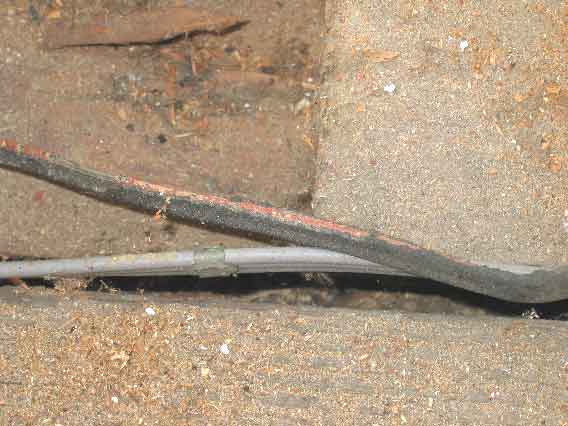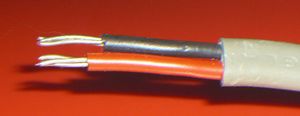Difference between revisions of "Historic Mains Cables"
(→VIR: 60C) |
|||
| Line 22: | Line 22: | ||
** singles drawn into conduit | ** singles drawn into conduit | ||
* Most VIR wiring doesn't include an earth wire, which is sometimes run as a separate uninsulated single. | * Most VIR wiring doesn't include an earth wire, which is sometimes run as a separate uninsulated single. | ||
| − | * | + | * Rated to 60C |
* Rubber insulation perishes, cracks & falls off | * Rubber insulation perishes, cracks & falls off | ||
* Properties with VIR cable are usually in urgent need of rewiring, and may represent a significant safety risk. However some of the Jute / Hessian reinforced rubber cables that are often seen on consumer unit incomers are still often relatively safe. | * Properties with VIR cable are usually in urgent need of rewiring, and may represent a significant safety risk. However some of the Jute / Hessian reinforced rubber cables that are often seen on consumer unit incomers are still often relatively safe. | ||
| Line 37: | Line 37: | ||
This situation is quite different to early American rubber wiring, which is usually still in sound condition, due to the use of a different rubber forumlation. | This situation is quite different to early American rubber wiring, which is usually still in sound condition, due to the use of a different rubber forumlation. | ||
| − | |||
==TRS== | ==TRS== | ||
Revision as of 21:53, 30 August 2009
Before the 1960s several types of cable were used at various times.
Paper
- Paper insulation
- From the WW1 era
- Very rare now
Lead sheathed
- Common in 1930s for socket circuits
- Used as exterior farm cable well after that
- Lead sheath does not make reliable earth connections
- Rubber inner insulation
VIR
- Vulcanised India Rubber insulated cable.
- Along with imperial T&E, one of the most common historic wiring cables still in use
- Comes in 2 forms:
- Twisted pair, cotton/rubber insulated, with no outer sheath
- singles drawn into conduit
- Most VIR wiring doesn't include an earth wire, which is sometimes run as a separate uninsulated single.
- Rated to 60C
- Rubber insulation perishes, cracks & falls off
- Properties with VIR cable are usually in urgent need of rewiring, and may represent a significant safety risk. However some of the Jute / Hessian reinforced rubber cables that are often seen on consumer unit incomers are still often relatively safe.
A good percentage of the remaining old VIR wiring is now in a dangerous condition, especially at termination points. It is common to see insulation that has fallen off, often leaving live & neutral conductors bare, unsupported and in very close proximity. In the worst cases 2 bare conductors can be found twisted round each other with nothing rigid to support them.
The outer insulation has failed on the black sheath of the cable, and in one place the insulation on the inner live wire has also cracked off. This cable is in a very poor state, and is potentially very dangerous.
The rule of thumb with old rubber wiring is
- replace it as soon as possible
- don't move it at all, even small movement sometimes causes shorts.
This situation is quite different to early American rubber wiring, which is usually still in sound condition, due to the use of a different rubber forumlation.
TRS
- Tough Rubber Sheath
- Rubber insulated conductors with a rubber outer sheath
CTS
- Cab Tyre Sheathed
- Tinned copper conductors, each core insulated with VIR, & cab tyre outer sheath
- Single, Flat Twin and Flat Triple
- (I'm not familiar with this one, but presumably it looks like TRS)
Aluminium
- Cheaper alternative to copper
- Used from 1950s to 1970s, and old stock sometimes used into the 1980s.
- The insulation & sheathing is mostly the same as T&E - PVC for decades, may be rubber on older cable.
- A known fire risk
- Aluminium cable creeps, oxidises & fractures, all of which can cause fires.
- Requires special connections, do not connect to old ali cable using connectors intended for copper.
- Al requires a larger conductor size than Cu for the same current rating
- Presence of aluminium cable may be considered a material fact for insurance.
- The main problem with ali cable is its thermal expansion coefficient. Repeated temperature cycling causes it to come loose at connection points, and it then oxidises, and aluminium oxide is an insulator. Bad connections generate excessive heat and fire can break out.
Copper Clad Aluminium
- Each conductor has an aluminium core surrounded by copper
- An attempt to improve the properties of ali cable
- Significantly better than al, the surface oxidation problem is eliminated, creep reduced & the risk from cracking more or less eliminated
PBJ
- PolyButyl Jute insulated cable
- Rubberised Hessian appearance to the sheath.
- The surface is these cables is quite uneven
- Commonly used for mains incomer insulation
- Lots of old PBJ is still safely in service
Imperial T&E
Older T&E wiring having similar construction to today's cables.
- 7/.029 T&E
- imperial 7 stranded version of 2.5mm² T&E
- Ashathene T&E
- Precursor to PVC T&E
- PVC outer VIR inner
- an early T&E cable
- 2 core T&E
- no earth, used for lighting circuits, or power circuits with a separate (usually uninsulated) single run alongside to provide an earth.
PVC and ashathene versions of this cable last well and are usually in good condition, but rubber does not last well long term.
PVC outer rubber inner cable can have its rubber ends sleeved to make it safe, as its only the ends where exposed to air where the rubber becomes brittle and falls off. Cable with rubber outer insulation can not be made safe this way.

